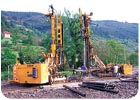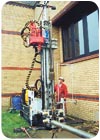
The successful execution of a large number of specialty geotechnical construction techniques necessitates the efficient and safe drilling of holes through any and all ground conditions.
The specialty geotechnical construction processes of routing, anchoring, micropiling, soil nailing and ground freezing all require the drilling of holes through overburden and rock. Part 1 of the article series focused on rock drilling; here, we look at overburden drilling.
Overburden drilling can be more complex and difficult than rock drilling, and often is far more controversial when consideration is given to levels of environmental acceptability. Regarding the fundamental control exerted by the stability of the drilled hole (i.e., its ability to maintain shape and size without detriment to the surrounding ground after withdrawal of the drilling system), Figure 1 provides the basic method selection guide. It must be noted that this relates only to routine production drilling for geotechnical construction purposes. Core drilling in overburden is not viable in this context, although it obviously is an integral part of many exploration and verification projects.

(Click Image to Enlarge)
- Cost considerations (per lineal foot, and as related to project size).
- Drill rig access restraints.
- Hole depth, diameter and inclination.
- Flush collection and disposal concerns, noise and vibrations.
- Possible impact of method on subsequent ability of hole to satisfy the project goals (e.g., bentonite slurry must not be used to stabilize holes which must later transfer peripheral bond, as in the case of nails, anchors and micropiles)
- Regional preference, and contractor paradigms, experience and resources.

Figure 2. Basic overburden drilling technique selection guide. (Click Image to Enlarge)
Stable Soil Methods
In appropriate soils, and when in a single, continuous string, mounted on large crawler-mounted rigs or suspended from crane leads, solid-stem continuous flight augers can provide extremely high productivities. Solid-stem continuous flight augers are a traditional, relatively simple technology, often used for soil nailing in the western United States and parts of Europe, providing holes 4 inches to 12 inches in diameter to maximum lengths of about 100 feet.Where flush return need not be carefully controlled, on technical and/or environmental grounds, then rotary or rotary percussive methods can be used. Such methods may be used to “predrill” through bouldery or otherwise obstructed overburden as a prelude to the subsequent installation of a casing. Use of such methods in overburden must only be conducted with extreme care, especially when slope or structural stability is an issue. Examples of successful use include nail hole drilling, predrilling for micropiles and jet grouting in karstic limestone.

Access issues are a key consideration when selecting a drilling method.
Unstable Soil Methods
Hollow-stem continuous flight augers are used in unobstructed ground to maximum depths of 100 feet for a wide range of applications (6-16 in. diameter). For anchors, auger outside diameters of 8 inches to 18 inches and inside diameters of 2? inches to 4 inches typically are used, protected by “knock off” bits. This technique is not recommended for holes shallower than 30 degrees (for deviation control) or in cohesionless or uncemented soils, particularly under the water table (for cavitation prevention). Hollow-stem continuous flight augers do not permit the application of high grout pressures during withdrawal of the auger, following placement of the central tendon or grout tube.Combination methods involve two or more principles combined to meet or exploit certain ground or project restrictions. For example, an open-ended casing can be driven or rotated full depth without flush. The soil that is left inside the casing then is augered or flushed out without fear of flush escaping into the surrounding ground mass.
In unobstructed ground, a common choice for quickly penetrating through potentially unstable materials (e.g., cohesionless soils) is to use some form of drilling slurry in combination with rotary drilling. As opposed to the use of water or air, such slurries have a range of specific gravities and viscosities, and will have other properties, such as the ability to coat the borehole wall with a coat or “filter cake” of material, creating stability. Slurries can be prepared from bentonite, polymer, or (as in Italy) a “self-hardening drilling mud,” i.e., a clay slurry incorporating cement. It is essential that the method is not in conflict with project goals. Bentonite slurry should not be used for anchors, nails or micropiles, while polymer slurries must totally degrade when touched by cement grout tremied into the hole (“calcium shock”). The special logistical provisions needed to mix, inject, collect, clean and recycle such slurries may offset the potential advantages of high productivity afforded by this method.
Based on installing casing by rotary or rotary percussive methods, the classification is shown in Table 1. In general, the methods are arranged in ascending order of technological complexity, the particular need for which will reflect the “difficulty” of the ground and environmental restrictions. Thus, in most urban areas, and particularly in ground containing natural and artificial obstructions, some form of cased method is essential. Contractors east of the Mississippi River and in the Pacific Northwest, therefore, tend to have the most experience and expertise. All methods except Method 1a (Drive Drilling) need some type of drill flush. An excellent level of technical support and advice also is available from the manufacturers and suppliers of drilling rigs and equipment. Sonic drilling also has great potential for the installation of casings through overburden, and into rock.
Report Abusive Comment